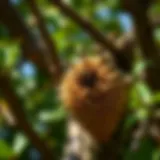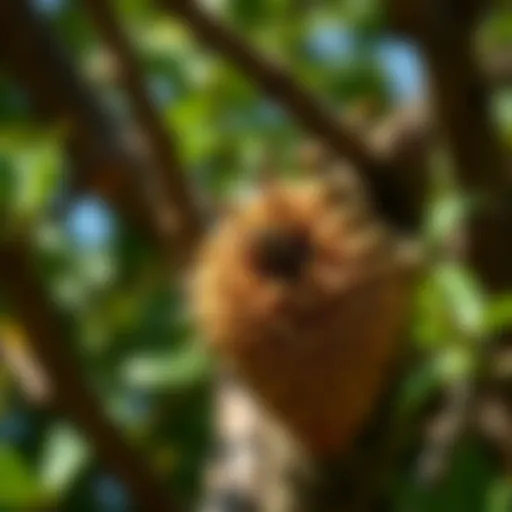Effective Ways to Eliminate Rats from Your Yard
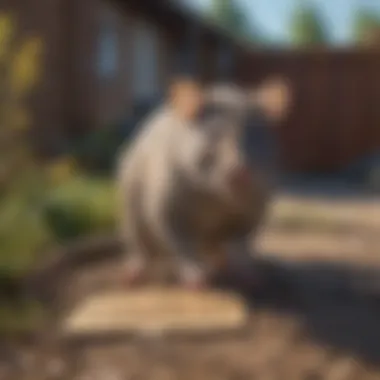

Intro
Encountering rats in your yard can be a distressing experience for homeowners. These rodents can pose various health risks and cause property damage if left unchecked. This article will provide a detailed guide on how to effectively eliminate rats from your outdoor space, focusing on key steps from identifying signs of an infestation to implementing effective prevention and treatment strategies.
Pest Identification
Understanding how to identify rats is crucial for effective pest management. Two common species of rats found in residential areas are the Norway rat and the roof rat.
The Norway rat is hefty, with a robust body that can weigh up to a pound. Their fur is coarse and brownish-gray. They typically have a blunt snout and short tail, making them distinct from other rodents. Conversely, the roof rat is slimmer and more agile. They often have black fur and a longer tail, which is almost as long as their body. Recognizing these differences can assist in identifying the type of rat invading your yard.
Signs and Symptoms of Infestations
Identifying a rat problem early can save time and effort in controlling the population. Here are some indicators to look for:
- Droppings: Dark, pellet-shaped droppings scattered around your yard.
- Gnaw Marks: Fresh gnawing seen on wires, wood, or containers.
- Burrows: Holes dug in the ground, especially near fences or under decks.
- Nests: Insulated areas created from shredded materials like paper or fabric.
- Footprints: Distinctive footprints in soft soil or dust.
If you notice any of these signs, it is essential to take immediate action to address the issue before it escalates.
Prevention Strategies
Preventing a rat invasion is often easier than dealing with an already established population. Taking proactive measures can safeguard your yard.
Home Maintenance Tips for Pest Prevention
- Seal Entry Points: Inspect your property for holes or cracks. Use steel wool or caulking to seal these openings.
- Proper Waste Management: Keep garbage bins tightly sealed. Avoid leaving pet food outside, which can attract rodents.
- Landscape Management: Trim back bushes and trees to reduce nesting areas. Keep firewood stacked away from your home.
Natural Deterrents and Barriers
Many homeowners prefer using natural methods to deter rats. Some options include:
- Peppermint Oil: Rats are known to dislike the strong scent of peppermint. Mix it with water and spray around entry points.
- Ultrasonic Repellents: These devices emit ultrasonic sounds that can deter rodents without chemicals.
By establishing these preventative measures, the likelihood of an infestation may be significantly reduced.
Treatment Options
If infestations do occur, it is essential to address them promptly and effectively.
Overview of Chemical vs. Natural Treatments
Chemical treatments often involve poisons that are effective but can pose risks to pets and children. Natural options tend to be safer but may require more persistent application. Homeowners need to weigh the pros and cons carefully.
Step-by-Step Guides for DIY Treatments
- Setting Traps: Choose snap traps for quick results. Place them near droppings or burrows. Use peanut butter as bait.
- Bait Stations: If using poison, opt for tamper-resistant bait stations that keep other animals safe.
- Regular Monitoring: Check traps daily and replace bait as needed to maintain effectiveness.
Monitoring and taking swift action are key to keeping your yard free of rats.
By understanding how to identify these pests, implementing preventative strategies, and selecting appropriate treatment options, homeowners can effectively manage rat problems and maintain a healthy outdoor environment.
Prolusion to Rat Infestations
Dealing with a rat infestation in your yard can be a distressing experience. Understanding this issue is crucial for homeowners. Rats not only pose health risks but can also cause serious damage to property. This article will explore effective strategies to manage and eliminate these pests. By recognizing rat behaviors and the signs of infestation, homeowners can take informed actions. The benefits of this knowledge extend beyond immediate removal; they also aid in maintaining a safe and healthy environment in the long term.
Understanding Rat Behaviors
Rats are adaptive creatures that thrive in diverse environments. Understanding their behaviors is essential for effective control. They are mostly nocturnal, emerging in the night to seek food and shelter. Their keen sense of smell helps them locate food sources, which can include debris, pet food, and unsealed garbage. Creating awareness about their habits can enlighten homeowners about the preventive measures needed. Additionally, rats are social animals, often seen in groups, which can escalate problems quickly.
Maintaining a clean yard is vital, as rats can easily find concealment among clutter. Their nesting habits are significant; they typically create burrows close to food and water sources, forming nests in hidden locations such as sheds or beneath decks. Knowing these behaviors allows homeowners to adjust their environments accordingly, proactively reducing rat attractants.
Common Signs of Infestation
Identifying the presence of rats in your yard is the first step in resolving an infestation. Common signs include:
- Droppings: Rat droppings are dark and rod-shaped, often found near food sources or where they enter your yard.
- Gnaw Marks: Rats will chew on wood, plastic, and even electrical wires. Look for fresh gnawing, which indicates active infestations.
- Nesting Material: Soft materials like shredded paper, cloth, or insulation can indicate nesting areas.
- Tracks and Trails: Footprints or tail marks in dust or soil can help identify rat activity.
Recognizing these signs early can prevent a more extensive infestation, saving time and effort down the line.
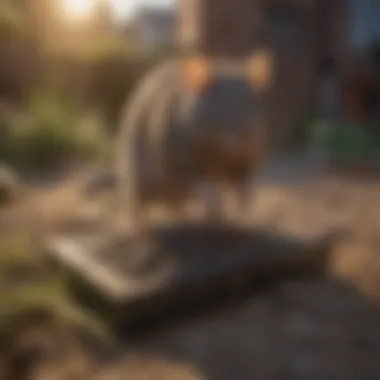

By staying vigilant for these indicators, homeowners can react swiftly. Early detection and understanding rat behaviors can significantly ease the process of managing and removing these pests.
Identifying Rat Species
Identifying rat species is a crucial step in the process of managing a rat infestation in your yard. Different types of rats exhibit distinct behaviors, preferences, and nesting habits, which influence the methods used for control and elimination. By understanding which species you are dealing with, you can tailor your approach to be more effective.
Not only does identifying the species help in selecting appropriate traps or baits, but it also provides insight into their life cycles and breeding patterns. For instance, Norway rats tend to burrow in the ground, while roof rats prefer to nest in higher areas such as trees or attics. Choosing the right strategies can significantly increase your chances of success. Moreover, it helps you avoid common mistakes, such as using traps designed for one species on another.
Norway Rats
Norway rats, also known as Rattus norvegicus, are the most common species found in urban areas. They are typically larger than roof rats, with a heavier body and thick tails. Adult Norway rats can weigh up to a pound and measure about 12 to 18 inches in length, including their tail. They are known for their burrowing behavior and often create complex tunnel systems in yards, gardens, or under buildings.
These rats are more likely to be active at night, seeking food and shelter in nearby residential areas. They have a strong preference for environments that offer easy access to food, so it is crucial to eliminate potential food sources to deter them effectively.
Roof Rats
Roof rats, or Rattus rattus, are slender and agile, making them adept climbers. They usually have darker fur and a longer tail compared to their Norway counterparts. Typically, roof rats can reach around 8 to 12 inches in length, not including their tail. They are often found in attics, roofs, and trees, preferring to nest high above ground.
Their diet consists mainly of fruits and nuts but will also forage for garbage or pet food if available. Understanding their nesting behavior can help you prevent them from becoming a nuisance. Observing their entry points is key in developing a focused response strategy.
Identifying Physical Features
Recognizing the physical features of each rat species is important for accurate identification. Here are some indicators:
- Body Size: Norway rats are larger than roof rats. Knowing the size can help you differentiate.
- Tail Length: Roof rats have long tails, about the same length as their body, while Norway rats have shorter tails.
- Fur Color: Roof rats usually display dark black or brown fur, whereas Norway rats tend to be gray with lighter underbellies.
- Ears and Eyes: Roof rats have larger ears and smaller eyes relative to their body size compared to Norway rats.
Understanding the physical features of rats can significantly improve your ability to identify the species. Identifying the rats accurately allows for a more effective pest control strategy.
Assessing Your Yard for Attractants
Understanding the factors that attract rats to your yard is crucial in managing and preventing infestations. Rats are opportunistic feeders and seekers of shelter, making your outdoor space potentially inviting. Assessing the attractants in your yard can help you identify problem areas and take proactive measures.
Food Sources
Food sources often play a significant role in drawing rats into residential areas. Leftover food from outdoor dining, pet food left behind, or open trash bins can be a feast for these rodents. To minimize this risk, consider the following practices:
- Secure Trash: Always cover garbage bins with tight-fitting lids. This limits the odor and access for rodents.
- Pet Food Management: Avoid leaving pet food outside for long periods. Store it inside when not in use to reduce accessibility for unwanted guests.
- Compost Piles: If you have compost, take care to avoid food scraps that may attract rats, such as meats and dairy products.
- Bird Feeders: Make sure bird feeders are not spilling food that rats can nibble on. Choose squirrel-proof feeders or clean up spills promptly.
Taking these measures limits available food and makes your yard less appealing to rats.
Shelter and Nesting Areas
Rats also seek shelter and nesting opportunities. Identifying potential hiding spots is necessary for prevention. Consider these points:
- Vegetation Overgrowth: Dense shrubs and tall grass provide hiding spots for rats. Keeping vegetation trimmed reduces areas where they can nest and hide.
- Woodpiles: Stacked firewood is a perfect breeding ground. Store wood off the ground and away from your home.
- Openings Around Structures: Inspect your home and yard for holes or cracks where rats can enter. Seal openings with appropriate materials, like steel wool or caulk.
- Debris: Clear debris, such as fallen leaves, cardboard, or unused equipment, which can provide coverage and nesting sites.
By maintaining a tidy landscape and reducing hiding spots, rats are less likely to take up residence in your yard.
"Prevention begins at home. Assessing your yard not only identifies attractants but also highlights necessary changes to make the space less hospitable to pests."
Preventive Measures to Control Rat Populations
Preventive measures play a crucial role in managing rat populations in residential yards. By taking proactive steps, homeowners can significantly reduce the likelihood of rat infestations. It is far easier to prevent a problem than to deal with it after it escalates. Addressing the factors that attract rats to your yard helps maintain a healthier environment for your home and community. This section will outline effective preventive approaches that target the specific behaviors and habitats of rats.
Yard Maintenance Tips
Keeping your yard well-maintained is essential for deterring rats. This includes regular upkeep to eliminate potential nesting sites. Here are some key practices to follow:
- Mow Your Lawn Regularly: Overgrown grass provides cover for rats. Short grass makes it harder for them to hide.
- Trim Shrubs and Hedges: Dense underbrush can serve as nesting areas. Regular trimming reduces these hiding spots.
- Remove Debris: Dispose of any leaf litter, wood piles, or compost heaps that might provide shelter to rats.
- Store Firewood Safely: Keep firewood elevated and away from your home to prevent rats from nesting within piles.
- Check for Holes and Gaps: Inspect your yard's perimeters for gaps in fences or walls where rats may enter. Sealing these voids will lessen access points.
Proper Waste Management
Another effective measure is managing waste appropriately. Waste attracts rats, as they seek readily available food sources. Here are essential tips:
- Secure Trash Bins: Use bins with tight-fitting lids to prevent access to food waste. It's important to clean bins regularly to eliminate odors.
- Store Pet Food Properly: If you have outdoor pets, avoid leaving their food out overnight. Store food in sealed containers.
- Compost Carefully: If you compost yard waste, ensure it is in a secure bin. Open piles can attract rats looking for food scraps.
- Prompt Disposal of Garden Waste: Dispose of fallen fruits, vegetables, and other organic waste quickly to minimize attraction.
Remember: Keeping your environment clean and organized is a significant step in preventing rat problems. Regularly assessing and improving your yard's sanitation will reduce the chances of attracting these pests.


By implementing these preventive measures comprehensively, homeowners can mitigate the risks posed by rat infestations effectively. Simple maintenance and responsible waste management not only deter rats but also promote a more inviting and sustainable yard.
Effective Trapping Techniques
When it comes to dealing with rats in your yard, effective trapping techniques play a crucial role. Trapping is often preferred over using poisons because it allows for more controlled and humane removal of these pests. Understanding how to select the right traps and how to use them effectively is essential for any homeowner facing this issue. Not only does effective trapping reduce the rat population, but it also helps to protect your landscaping and ensures a safer environment for pets and children.
Choosing the Right Trap
Selecting the appropriate trap is a vital step in the trapping process. There are several types of traps available, and each has its own advantages. Common options include:
- Snap traps: These are mechanical traps that quickly kill rats upon contact. They are straightforward to use and can be placed indoors and outdoors.
- Live traps: These traps capture rats unharmed, allowing for their release in a suitable location. However, they require regular checking to ensure no animal is left inside for long.
- Electric traps: These provide a quick and humane kill by delivering a high-voltage shock. They are generally more costly but can be effective, especially in larger infestations.
When choosing a trap, consider the specific rat species prevalent in your area, as this can influence which type of trap will be most effective. Norway rats, for example, may require larger traps compared to smaller roof rats.
Setting Traps Properly
Once you've chosen the right trap, the next step is to set it up correctly. Misplaced traps can lead to fewer captures. Here are some critical guidelines to follow:
- Location: Place traps in areas where you have noticed rat activity or signs of infestation. Look for droppings, footprints, or gnaw marks.
- Baiting: Use attractive bait like peanut butter, dried fruit, or nuts. Be generous but also ensure that it isn't easily accessible to other animals.
- Positioning: Position snap traps at right angles to walls or in narrow passages where rats commonly travel. Live traps should be placed with the opening facing the direction of rat movement.
By placing traps strategically, you increase your chances of successfully capturing the rats visiting your yard.
Regular Monitoring and Maintenance
After setting the traps, regular monitoring is essential. Check traps daily to ensure they are functioning correctly and to remove any trapped rats as soon as possible. This not only prevents further suffering but also minimizes the risk of the area becoming a breeding ground for bacterial pathogens.
Moreover, maintaining the traps is crucial. Clean them regularly to remove any food residue or odors that might repel rats. Additionally, it is wise to reposition traps periodically, especially if you notice fewer captures than expected. Rats can often become trap-shy, so varying your approach helps to adapt to their behavior.
"Effective trapping is not just about killing rats; it is about understanding their habits and adapting your strategy accordingly."
In summary, effective trapping techniques require thoughtful selection of the right traps, proper placement, and vigilant maintenance. By following these guidelines, homeowners can more effectively manage the rat populations in their yards.
Using Baits and Poisons Carefully
Using baits and poisons to control rat populations is a significant aspect of comprehensive pest management. While these methods can be effective in eliminating rodents, they also come with potential risks and responsibilities. Understanding how to use these substances safely can ensure the safety of your family, pets, and the environment. It is crucial to investigate the various types of rodenticides available, as well as their application methods. This knowledge not only enhances the effectiveness of your efforts but also minimizes unintended harm.
Types of Rodenticides
Rodenticides can be broadly categorized into different classes based on their active ingredients and mechanism of action. Here are some common types:
- Anticoagulants: This type prevents blood from clotting, leading to internal bleeding in rodents. Brands like Bromadiolone and Brodifacoum are popular in this category. They often require multiple feedings for effectiveness.
- Acute toxins: These substances, such as Strychnine and zinc phosphide, cause rapid fatalities. These products work quickly, but they can pose higher risks to non-target species.
- Ingested bait: This includes bait formulations that are specifically designed for rodents. They are usually available as blocks, pellets, or grain.
It is essential to read product labels carefully as they provide critical information about safety, application rates, and target rodents.
Applying Baits Safely
To maximize the effectiveness of rodenticides while minimizing dangers, safe application practices should be followed. Here are some guidelines:
- Placement: Always place bait in areas that are inaccessible to children and pets.
- Use bait stations: These devices not only secure bait but also protect it from contamination. Place them along walls, near burrows, and in other areas of rodent activity.
- Avoid overuse: Follow the recommended bait amounts to decrease the chances of rodent resistance and the potential for accidental poisonings.
- Monitor bait take: Check regularly to see if rodents are consuming the bait. Replenish only when needed.
- Dispose of dead rodents properly: Use gloves when handling dead rats and ensure you place them in sealed bags. Dispose of these bags according to local regulations.
Following these steps is important for an effective and responsible approach to rodent control. Misuse of poisons can lead to unintended consequences in the ecosystem.
Educating yourself about the nuances of using baits and poisons can significantly empower homeowners in managing rat issues effectively. This careful approach is not only about getting rid of rats but also ensuring the well-being of your household and community.
Long-Term Prevention Strategies
Effective management of rat infestations goes beyond merely addressing immediate concerns. Long-term prevention strategies are essential to ensure that the problem does not resurface. By taking proactive measures, homeowners can create an environment that is less conducive to rodent habitation. Implementing these strategies also saves time and money, reducing the need for repeated pest control efforts.
Landscaping Adjustments
Adjusting your landscaping is a key aspect of preventing rat infestations. Specific landscape features can attract rats and provide the shelter they seek. Focus on the following elements when implementing landscaping adjustments:
- Trim Overgrown Vegetation: Dense bushes or tall grass can offer perfect hiding spots for rats. Regularly trimming these areas can deter such pests from making a home nearby.
- Remove Debris and Clutter: Piles of leaves, branches, or any leftover building materials serve as excellent nesting sites. Keeping your yard clean and organized is vital in preventing environmental factors that attract rats.
- Use Rodent-Resistant Plants: Consider planting herbs and flowers that are less appealing to rodents. For instance, mint and marigold can be effective deterrents due to their strong scents.
- Limit Mulch Use: While mulch can enhance garden aesthetics, it can also attract rats. If you must use mulch, opt for fine materials that are less hospitable to rodents.
Making these landscaping adjustments not only helps in reducing rat attractiveness but also enhances the overall look and health of your yard.
Building Structural Barriers
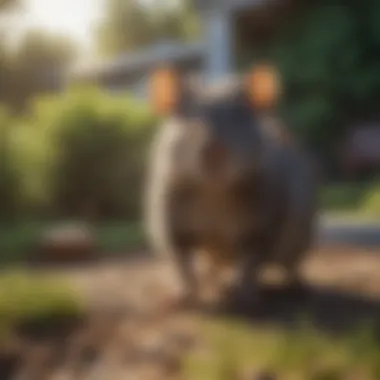

Creating physical barriers is another crucial long-term strategy. This involves reinforcing your home and yard against potential rat entry points. Key considerations include:
- Seal Entry Points: Inspect your property for small openings where rats could enter. This includes gaps around windows, doors, and pipes. Use materials like steel wool or caulking to close these gaps effectively.
- Install Proper Fencing: A well-constructed fence can keep rats out of your yard. Ensure that it is buried a foot underground to prevent rodents from burrowing underneath.
- Elevate Storage Areas: Storing wood, debris, or heavy equipment close to the ground can attract rats. Placing these items on elevated platforms can reduce the likelihood of rats finding shelter.
- Regularly Inspect and Maintain Structures: Keeping an eye out for potential vulnerabilities in sheds, garages, and walls is relevant. Attend to any damages immediately to prevent rats from finding a way in.
By focusing on these structural barriers, homeowners can create a less inviting environment for rats, bolstering the effectiveness of other prevention strategies.
"Consistent maintenance and vigilance can significantly reduce rat populations in residential areas."
In summary, the combination of landscaping adjustments and building structural barriers forms a robust defense against rats. These long-term strategies emphasize the importance of a proactive approach in maintaining a rodent-free yard.
When to Call a Pest Control Professional
In dealing with rat infestations, there may come a point where your efforts to manage the situation become overwhelming. While many homeowners can handle minor issues through trapping or preventive measures, some infestations may require professional intervention. It is crucial to recognize the signs that suggest it is time to call a pest control expert. This decision not only helps to resolve the problem effectively but also ensures the safety of your household.
Signs that Indicate Professional Help is Needed
There are several indicators that suggest you should seek professional help for a rat issue. Here are some key signs:
- Heavy Infestation: If you notice a large number of rats or consistent signs of activity, it is likely too much for DIY methods alone.
- Health Risks: Rodents can carry diseases. If anyone in your home experiences unexplained illness that may correlate to a rat infestation, seek immediate help.
- Failure of DIY Approaches: When traps or baits are continuously ignored or the problem persists despite your efforts, it is time to consult a professional.
- Structural Concerns: If rats seem to be entering your home through small gaps or weaknesses in the structure, an expert can evaluate and rectify these vulnerabilities.
"Ignoring signs of a serious infestation could lead to greater structural damage and health issues."
Choosing a Reputable Pest Control Service
Selecting the proper pest control service is essential to effectively combat a rat infestation. Here are some considerations to keep in mind:
- Reputation: Check online reviews and testimonials from past customers. It's crucial to choose a service that is well-reviewed and trusted by the community.
- Experience: Consider how long the company has been in business. Experienced professionals are often more adept at handling complex infestations.
- Licenses and Certifications: Ensure the pest control service is licensed and has the necessary certifications. This guarantees that they are qualified to handle infestations safely and legally.
- Prevention Strategies: A good service will not only focus on eradication but also provide advice on long-term prevention to avert future rodent problems.
- Cost Transparency: Be wary of companies that do not provide clear estimates upfront. A reputable service will offer detailed information about the cost involved.
By recognizing the signs of a severe infestation and knowing what to look for when hiring a pest control service, homeowners can ensure they are taking the right steps to protect their homes and families from the hazards associated with rats.
Myths and Misconceptions about Rats
Understanding myths and misconceptions about rats is crucial for homeowners dealing with rat infestations. These misconceptions can lead to ineffective strategies or an increase in panic. By debunking these myths, we can clarify the actual behaviors and characteristics of rats, which can facilitate more effective control measures.
Addressing these topics helps dispel fear and encourages a more rational approach. When we acknowledge and understand rat behavior, we are better equipped to manage and prevent infestations.
Common Myths Debunked
- Rats only live in dirty places.
This is not entirely accurate. While rats are attracted to areas with readily available food and sheltered spaces, they can adapt to live in various environments, including clean ones. They are resourceful and can find ways to survive regardless of cleanliness. - Rats are not intelligent.
In reality, rats are highly intelligent creatures. They can learn quickly, navigate mazes, and even remember paths to food sources. This intelligence makes them difficult to trap and control. - If you see one, there are many more.
While it's true that one rat might indicate a potential issue, it's not a guaranteed sign of a large infestation. A lone rat could be a curious visitor or looking for food, not necessarily a symptom of a bigger problem. - Rats are harmless and won't attack humans.
Although most rats prefer to avoid humans, they can pose risks, especially if cornered or threatened. They can bite and carry diseases, so it is important to treat any sighting seriously. - All rats carry diseases.
While rats can be carriers of disease, not all of them are infected. It’s essential to understand the risks but also recognize that handling them appropriately and with caution can mitigate those risks.
Understanding the Rat Life Cycle
A key element in managing a rat problem is an understanding of their life cycle. This knowledge can inform prevention strategies and highlight when action is necessary.
Rats reach sexual maturity at three to five months. A female can have several litters each year, and each litter can comprise up to twelve young. The entire cycle allows their populations to grow rapidly if not addressed in a timely manner.
Understanding this life cycle can help you recognize signs of an infestation earlier, leading to a quicker response. Furthermore, knowledge of their behavior patterns can inform how you set traps, apply repellents, or modify your yard for better prevention.
It's crucial for homeowners to grasp how quickly a small problem can escalate if early indicators are overlooked or misinterpreted. Effective control and prevention tactics rely on being proactive, rather than reacting too late.
"Addressing misunderstandings about rats can significantly improve your approach to controlling infestations."
By debunking myths and understanding their life cycle, homeowners can apply more rational and effective strategies in yard maintenance and rat control.
The End
The conclusion of this article serves as a vital component, synthesizing the comprehensive exploration of methods to rid your yard of rats. Addressing a rat infestation is not merely about immediate eradication; it’s about understanding behaviors, applying preventive measures, and maintaining your yard effectively over the long term. As home dwellers strive for a harmonious living environment, acknowledging the importance of both immediate action and ongoing vigilance becomes crucial.
Rat populations can grow quickly if left unchecked, making early detection and swift reaction imperative. The strategies discussed provide a structured approach to rat management, emphasizing environmentally responsible methods. Homeowners stand to benefit from the combination of trapping techniques and preventive measures outlined, ensuring their spaces remain rat-free.
"Being proactive in your yard can mean the difference between a temporary issue and a persistent problem."
The need for awareness does not end with the removal of rats. Continuous maintenance of your yard can significantly minimize future infestations. Implementing practices that deter rodents is key. By fostering an environment that is uninviting to rats, you not only enhance your outdoor space but also contribute to the overall health of your property.
Summary of Key Points
- Understand Rat Behaviors: Familiarize yourself with how rats live and age.
- Identify Signs of Infestation: Recognize droppings, nests, and damage to property.
- Trapping Techniques: Use appropriate traps and check them regularly.
- Long-Term Prevention: Implement landscaping changes and proper waste management.
- Call Professionals When Necessary: Know when to seek external help.
Encouragement for Ongoing Maintenance
Maintaining your yard in a rat-free state requires ongoing commitment. Regular checks for any new signs of infestation are vital. Ensure that your property is not providing food or shelter for rats. Here are a few tips to keep in mind:
- Regularly Clean: Remove debris and food sources that may attract rats.
- Inspect Structures: Look for entry points and cracks, sealing them promptly.
- Educate Your Family: Ensure that everyone understands what attracts rats and how to avoid attracting them.
Staying proactive not only protects your yard but also contributes to a more pleasant living environment for everyone in your household.


